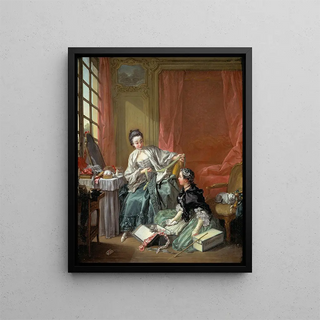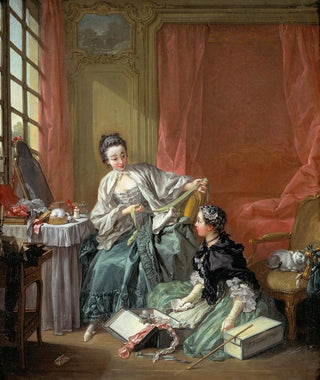Art print | The milliner - François Boucher


View from behind

Frame (optional)
In the enchanting world of rococo art, the art print "La modiste" by François Boucher stands out for its elegance and delicacy. Painted in the 18th century, this canvas evokes not only the fashion of the time but also the very spirit of a society in full effervescence. The artist, through this representation, immerses us in a world where beauty and frivolity intertwine, offering a fascinating glimpse into the daily life of women of his era. The scene, both intimate and refined, captures attention and invites prolonged contemplation, revealing the subtleties of human emotions and social interactions.
Style and uniqueness of the art print
Boucher's style is immediately recognizable, characterized by soft, luminous colors, rounded forms, and a skillfully orchestrated composition. "La modiste" is no exception to this rule. The pastel palette, with its shades of pink, blue, and cream, evokes an atmosphere of lightness and dreaminess. The meticulous details of the clothing and accessories demonstrate exceptional brushwork mastery, while the expressions of the characters, between joy and melancholy, add emotional depth to the scene. Every element, from the hat to the coiffure, is carefully arranged to create a visual harmony that transports the viewer into a suspended moment. This art print perfectly embodies the ease and sophistication of the ladies of the period, while also revealing the aesthetic and social concerns of a privileged milieu.
The artist and his influence
François Boucher, born in 1703, is one of the most emblematic painters of French rococo. His career, marked by success, places him at the heart of the artistic life of his time. As a court painter, he captured the essence of aristocratic taste, influencing not only his contemporaries but also future generations. His style, characterized by unparalleled sensuality and lightness, paved the way for many artists, while laying the foundations of an aesthetic that would endure beyond his era. "La modiste" fits into this lineage, illustrating the concerns and aspirations of a society in search of

Matte finish

View from behind

Frame (optional)
In the enchanting world of rococo art, the art print "La modiste" by François Boucher stands out for its elegance and delicacy. Painted in the 18th century, this canvas evokes not only the fashion of the time but also the very spirit of a society in full effervescence. The artist, through this representation, immerses us in a world where beauty and frivolity intertwine, offering a fascinating glimpse into the daily life of women of his era. The scene, both intimate and refined, captures attention and invites prolonged contemplation, revealing the subtleties of human emotions and social interactions.
Style and uniqueness of the art print
Boucher's style is immediately recognizable, characterized by soft, luminous colors, rounded forms, and a skillfully orchestrated composition. "La modiste" is no exception to this rule. The pastel palette, with its shades of pink, blue, and cream, evokes an atmosphere of lightness and dreaminess. The meticulous details of the clothing and accessories demonstrate exceptional brushwork mastery, while the expressions of the characters, between joy and melancholy, add emotional depth to the scene. Every element, from the hat to the coiffure, is carefully arranged to create a visual harmony that transports the viewer into a suspended moment. This art print perfectly embodies the ease and sophistication of the ladies of the period, while also revealing the aesthetic and social concerns of a privileged milieu.
The artist and his influence
François Boucher, born in 1703, is one of the most emblematic painters of French rococo. His career, marked by success, places him at the heart of the artistic life of his time. As a court painter, he captured the essence of aristocratic taste, influencing not only his contemporaries but also future generations. His style, characterized by unparalleled sensuality and lightness, paved the way for many artists, while laying the foundations of an aesthetic that would endure beyond his era. "La modiste" fits into this lineage, illustrating the concerns and aspirations of a society in search of






